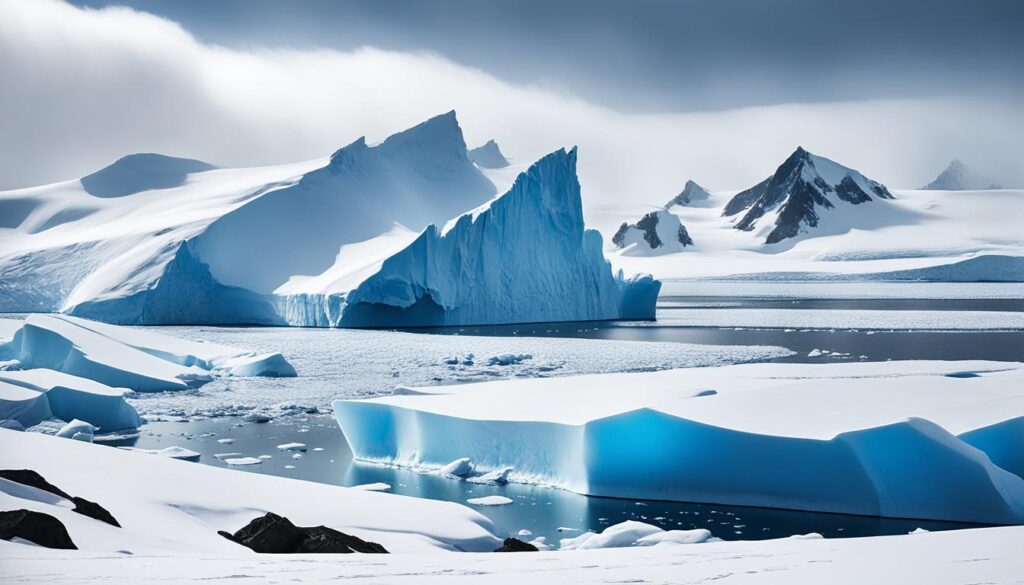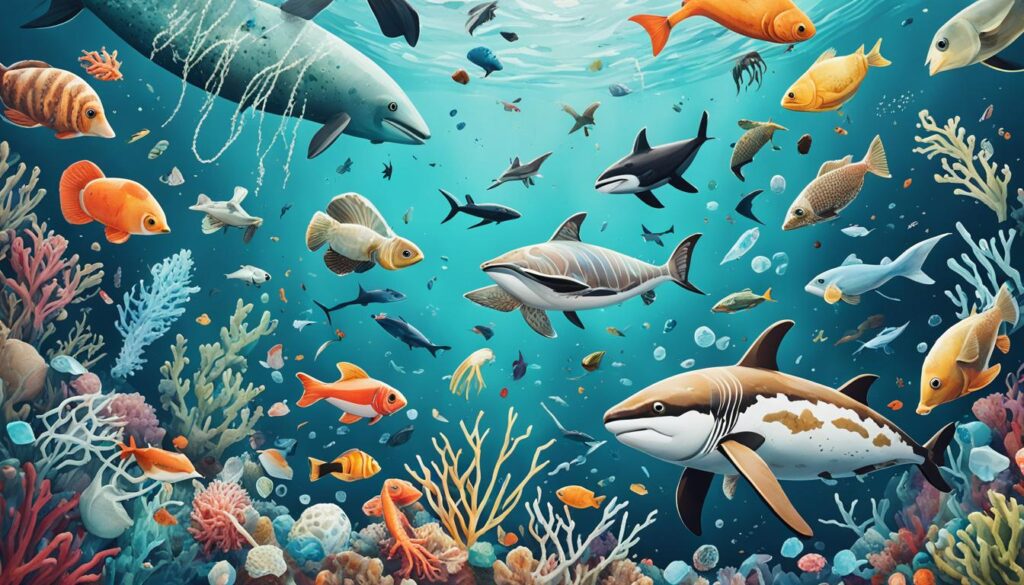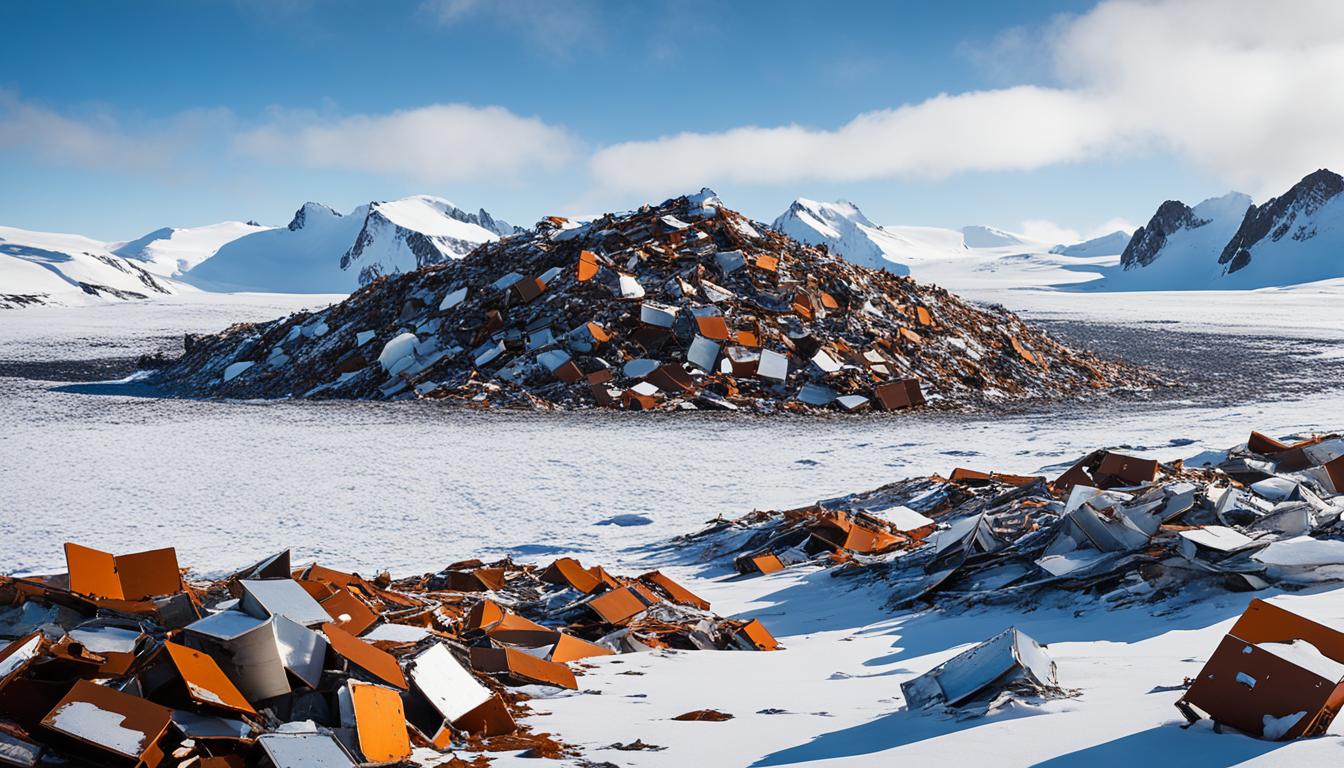The Antarctic continent is known for its clean environment. But, it now faces a threat from heavy metal pollution. These metals like lead, copper, arsenic, cadmium, and zinc have been coming to this area for centuries.
The first big increase in pollution was around 1200. This was when cities started in South America by the Chimú people. Then, with Spanish settlers in the 16th century and the Potosí silver mines, pollution got worse.
Industrial times in the 19th and 20th centuries made things even worse. The start of Australian lead mining in the late 19th century was a big spike in pollution.
This pollution is a big worry for the Antarctic ecosystem. Studies show these metals are everywhere – in seal hairs, sediments, and near research stations. Knowing where these pollutants come from and how they move is key to protecting this unique place.
Key Takeaways
- Heavy metal pollution, including lead, copper, arsenic, cadmium, and zinc, has been a growing problem in the Antarctic for centuries.
- The first detectable increase in pollution levels coincided with the establishment of urban communities by the Chimú people in South America around the year 1200.
- Pollution levels increased further after the arrival of Spanish settlers in the 16th century and the establishment of the Potosí silver mines.
- Industrialization in the 19th and 20th centuries led to even higher levels of heavy metal contamination in the Antarctic region.
- Understanding the sources, transport, and fate of these contaminants is crucial for developing effective strategies to protect the Antarctic ecosystem.
Introduction: The Pristine Continent Under Threat
Antarctica is far away, but it’s not isolated from the world’s environmental issues. Since the 1960s, pollutants have been found in Antarctic animals. This shows how pollutants travel long distances to reach the continent. The discovery of the Antarctic ozone hole in the 1980s showed how connected Antarctica is to the rest of the world.
Long-Range Transport of Contaminants to Antarctica
Antarctica is facing more heavy metal pollution today. This pollution comes from old mining and new industrial activities. For example, mining in South America since the 13th century has left lead in Antarctic ice.
Industrial growth in the 19th and 20th centuries made things worse. Pollution levels went up with events like the start of Australian lead mining and World Wars.
| Pollutant | Key Findings |
|---|---|
| Lead (Pb) | Concentrations in Antarctic environmental matrices (snow, ice, sediments, and biota) have decreased after the ban on alkyl-lead fuel additives. |
| Mercury (Hg) and Cadmium (Cd) | Concentrations in Antarctica are among the lowest globally, with exceptions in bioaccumulation in marine organisms. |
| Persistent Organic Pollutants (POPs) | Occurrence in Antarctic ecosystems could decrease following the entry into force of the Stockholm Convention. |
Marine life in Antarctica can absorb pollutants like POPs because of their biology. They also face threats from rising CO2 levels, acidifying water, and less sea ice due to melting glaciers.
“Reports of new persistent synthetic chemicals and plastic debris reaching Antarctica via long-range transport are continuously increasing.”
Antarctic Heavy Metal Pollution
Lead, Copper, Arsenic, Cadmium, and Zinc in Antarctic Seal Hairs and Sediments
The Antarctic environment is facing a big problem with heavy metal pollution. Studies show high levels of toxic metals like lead, copper, arsenic, cadmium, and zinc in seal hairs and sediments. This shows how pollutants can travel long distances and affect even the most remote places.
A 1500-year study of heavy metals in Antarctic seal hairs and sediments is worrying. It shows that these pollutants have been getting more common over time. This is a big threat to the Antarctic ecosystem.
Anthropogenic Contaminants in Polar Scientific Stations
More people in Antarctica, for research, tourism, and fishing, bring new species and pollution. Old ways of getting rid of waste and burning trash have hurt the environment near research stations. Now, not having good ways to treat wastewater brings more pollutants and harmful germs to Antarctica.
| Heavy Metal | Key Findings |
|---|---|
| Lead (Pb) | A 1500-year record in Antarctic seal hairs and sediments shows a significant increase in lead levels since the late 19th century, likely due to long-range atmospheric transport of this metal from industrialized regions. |
| Copper (Cu) | Elevated copper concentrations have been detected in Antarctic sediments, with potential sources including mining, industrial processes, and agricultural runoff transported to the region. |
| Arsenic (As) | Arsenic levels in Antarctic seal hairs and sediments have been found to be on the rise, raising concerns about its bioaccumulation and potential impacts on the local wildlife and ecosystems. |
| Cadmium (Cd) | The presence of cadmium in Antarctic environments is particularly worrying, as it is a known carcinogen and can have adverse effects on the reproductive and respiratory systems of organisms. |
| Zinc (Zn) | Zinc concentrations in Antarctic seal hairs and sediments have also shown a gradual increase, potentially due to a combination of natural and anthropogenic sources, such as mining and industrial activities. |
These heavy metals in Antarctica show how pollution can spread far and wide. We need to keep a close eye on pollution and work to fix it to protect this fragile place.
https://www.youtube.com/watch?v=Ad8Zot71_cY
Impact on Antarctic Ecosystems
Heavy Metal Accumulation in Marine Organisms
Marine life in Antarctica faces a big threat from toxic heavy metals and pollutants. These metals and pollutants build up in the bodies of marine creatures. This can lead to higher levels of toxins in seabirds and top predators.
Studies of ice cores show a long history of pollution in Antarctica. Lead, cadmium, and bismuth levels have gone up by at least 10 times since the 19th century. This is mainly because of mining in South America and Australia.
The first big increase in pollutants happened around 1200. This was when cities started to form in South America. Mining activities led to more pollution, especially with lead.
There was a drop in lead pollution from 1585 to 1591. This was during a time when diseases hit Andean communities hard and mining slowed down. Then, pollution went up again with industrial growth and global events like World Wars.
This pollution is a big threat to Antarctic life. It can harm the food web and the unique creatures living there. We need to understand where these pollutants come from to protect this fragile place.
“The involvement of benthic invertebrate communities in the Antarctic food chain can lead to the biomagnification of these contaminants, with elevated levels found in seabirds and other top predators.”
Climate Change and Contaminant Remobilization
The Antarctic environment is facing a big threat from climate change. Climate change is making the Southern Ocean waters more acidic. This, along with changes in sea ice and glacier meltwater, is testing the resilience of Antarctic ecosystems.
This makes them more vulnerable to pollutants from human activities. The risk of pollutants causing harm is higher in areas where humans have been active.
As ice melts and permafrost thaws in Antarctica, pollutants could become more available. Legacy pollutant concentrations in Antarctica are among the lowest globally, except for mercury and cadmium in marine life. But, new synthetic chemicals and plastic debris are still being added, and they don’t follow strict rules yet.
Human activities like research, tourism, and fishing have polluted parts of Antarctica. Reports of synthetic chemicals and plastic debris in Antarctica are increasing because of these activities. As climate change gets worse, the risk of pollutants moving around and harming the Antarctic environment is growing.
“Antarctica is covered by ~98% ice and ~2% exposed land. The ice-free area in Antarctica where permafrost can potentially occur is only 0.35%, equating to 45,000 km2 of the continent.”

We need a complex plan to tackle this issue. This includes better monitoring, stricter rules for scientific stations, and finding ways to clean pollutants from the Antarctic ecosystem. As we deal with climate change, the future of Antarctica’s untouched environment is uncertain.
Monitoring and Regulation Efforts
The Antarctic Treaty’s Protocol on Environmental Protection (ATPEP) calls Antarctica a “nature reserve, devoted to peace and science.” But, it doesn’t cover global issues. Human activities in Antarctica are growing, threatening its environment. We need better environmental monitoring and regulation at Antarctic scientific stations.
The Antarctic Treaty’s Protocol on Environmental Protection
The Antarctic Treaty’s Protocol on Environmental Protection (ATPEP) is a key agreement. It sets rules for environmental protection in Antarctica. Signed in 1991, it makes Antarctica a “nature reserve, devoted to peace and science.” It also has strict rules for human activities there.
But, it mainly focuses on Antarctica itself, not global environmental issues. So, activities like research, tourism, and mining still threaten the Antarctic ecosystem.
| Monitoring and Regulation Efforts | Description |
|---|---|
| Minamata Convention | A global treaty that aims to reduce emissions and releases of mercury, a highly toxic heavy metal, from various sources. |
| Stockholm Convention | An international agreement that targets the elimination or restriction of the production and use of persistent organic pollutants (POPs). |
| Need for Improved Monitoring and Regulation | Despite these global efforts, the environmental monitoring and regulation of activities around scientific stations in Antarctica remains a pressing concern, as the continent continues to face threats from various contaminants. |
We need a strong effort from Antarctic Treaty nations and the world to protect Antarctica better. This means improving protection measures and monitoring in the Antarctic region.
Bioremediation Strategies
The Antarctic environment faces a big problem with heavy metal pollution. Researchers are now using bacteria to help clean up. These bacteria can take in, change, or lock away harmful metals. This makes them key players in fighting environmental damage.
Deinococcus psychralcaliphila JI1D is one bacterium getting a lot of attention. It can handle a lot of heavy metals like zinc, copper, and arsenic. This makes it a great tool for bioremediation in the Antarctic environment.
Scientists use tools like Inductively Coupled Plasma—Mass Spectrometry (ICP-MS) to study this bacterium. They track how much heavy metals it can take in. This helps them understand how well it can clean up pollutants.
The use of bacteria for cleaning up goes beyond Antarctica. Many studies show that different bacteria can survive and adapt in polluted areas. They are finding new ways to deal with heavy metal pollution.
Bacteria could be a big help in fighting environmental damage. By using these tiny helpers, we can find new ways to clean up pollutants. This could make our environment healthier and more sustainable in the Antarctic and beyond.
| Heavy Metal | Concentration Range Tested (ppm) | Bacterial Strain | Remediation Potential |
|---|---|---|---|
| Zinc | 10 – 10,000 | Deinococcus psychralcaliphila JI1D | Able to accumulate and tolerate high concentrations |
| Copper | 10 – 10,000 | Deinococcus psychralcaliphila JI1D | Able to accumulate and tolerate high concentrations |
| Arsenic | 10 – 10,000 | Deinococcus psychralcaliphila JI1D | Able to accumulate and tolerate high concentrations |
Persistent Organic Pollutants in Antarctica
Antarctica, often seen as the untouched continent, faces threats from persistent organic pollutants (POPs). These chemicals last a long time and have entered Antarctica from far away. They came through the air and settled on the land and in the water.
POPs build up in the bodies of Antarctic marine animals, especially in seabirds that live a long time. Pelagic fisheries and emerging tourism activities might make POP levels go up a bit. This makes the situation worse for the environment.
Groups around the world are working to fix this problem. The United Nations Economic Commission for Europe (UNECE) protocol on POPs and the Stockholm Convention on POPs are leading the way. They want to control the use and release of these harmful chemicals. This helps protect places like Antarctica.
The United Nations Environment Programme (UNEP) has made Antarctica a top priority for checking on toxic substances. The Scientific Committee on Antarctic Research (SCAR) is doing a big study. They’re looking into where these pollutants come from, how they get there, and what harm they cause.
“Lead pollution from Australia reached Antarctica in 1889, long before the golden age of exploration on the continent.”
Studies show that lead pollution in Antarctica started coming from Broken Hill, New South Wales, Australia. This place has a lot of lead. Lead levels were highest around 1975 and are still three times higher than before.
Scientists are finding new ways to study POPs in Antarctica, like the TRACE facility in Australia. This helps them find very small amounts of pollution. By learning more about these pollutants, scientists can help make plans to clean up the environment. This will protect Antarctica’s unique ecosystem.
Microplastics: An Emerging Concern
The Antarctic environment is facing a new threat from microplastics. These tiny plastic pieces are less than 5 millimeters in size. They are found in the region, causing harm to its ecosystems.
Every year, the world produces over 350 million tonnes of plastics. Most of these come from fossil fuels, adding to the carbon footprint. Even with recycling and incineration efforts, most plastic ends up in landfills or nature, where it turns into microplastics.
Microplastics have been found in Antarctic seals and marine sediments. These tiny plastics can harm organisms by affecting their feeding, function, and ability to reproduce. Antarctic species, with their slow reproduction and narrow temperature range, are especially at risk.
High UV levels in Antarctic summers can speed up plastic degradation and spread it further. As more microplastics reach the region through air and sea currents, we need to act fast. Monitoring and reducing these plastics is crucial.
To fight microplastics in Antarctica, we must reduce plastic use, improve waste management, and study their effects on ecosystems. By acting now, we can protect the Antarctic environment and its unique life.

“The presence of microplastics in the Antarctic environment is an emerging concern that requires immediate attention. These synthetic particles can disrupt the delicate balance of the region’s ecosystems, posing a threat to the survival of its unique wildlife.”
The Role of Scientific Research
Scientific research is key to understanding how pollutants move and settle in the Antarctic environment. By looking at ice cores, sediments, and living organisms, scientists have learned a lot about heavy metals and persistent organic pollutants in the area. This knowledge helps make better decisions for protecting Antarctica.
Advancing Understanding of Contaminant Transport and Fate
Research into Antarctic ice cores shows that lead and other harmful heavy metals from mining reached the Southern Hemisphere by the 13th century. Heavy metal pollutants, especially lead, began to rise around 1200. This was when cities started to grow in South America.
A study by McConnell’s team at DRI looked into how humans affected lead pollution in Antarctica since 2,000 years ago. It was the first deep dive into thallium, bismuth, and cadmium pollution. The ice records show a drop in lead pollution from 1585 to 1591, which matched big health crises in Andean communities.
Industrial growth led to a big jump in pollutants, with a big rise at the start of Australian lead mining in the late 19th century. Pollution levels went down during World Wars and the Great Depression, showing how global events affected pollution.
The study used five ice cores from East Antarctica to track trace metals. It found lead, bismuth, and cadmium levels went up a lot after industrial times. Thallium levels stayed the same, making it a sign of volcanic activity over the past 2,000 years.
This scientific research was shared in top journals like Science of the Total Environment and Applied Sciences (Switzerland). It highlights the need to understand how pollutants move and settle in the Antarctic environment.
Bibliometric Analysis and Research Trends
Researchers have deeply studied the growth of studies on environmental pollution in Antarctica. These studies give us key insights into what topics are being explored, who is working together, and what new areas are being looked into. This helps us better understand the big environmental challenge we face.
Looking at over 100 scientific papers on heavy metal pollution in Antarctica from 2000 to 2020, we see a big increase in research. More papers and citations mean more people are paying attention and care about solving this problem.
Countries like Australia, China, Brazil, and Chile are leading the research. They show they are deeply involved in tackling pollution in Antarctica. Environmental science is a big part of this, showing how complex the issue is and the need for working together across different fields.
| Research Focus | Key Findings |
|---|---|
| Heavy Metal Pollution | Studies have found heavy metals like lead, copper, arsenic, cadmium, and zinc in Antarctic waters, sediments, and living things. These pollutants have been tracked for 1500 years, showing they are a long-term problem. |
| Hydrocarbon Contamination | Research shows how oil spills affect the environment in the Ross Sea. It also looks at metal levels in the Ross Sea during summer. Work is being done to clean up old whaling sites and recent oil spills. |
| Bioremediation Strategies | New studies are looking into using plants and microorganisms to clean up pollutants. This could be a way to deal with pollution in Antarctica’s tough conditions. |
Looking at keywords and trends, we see a big focus on heavy metal pollution in Antarctica. Researchers are working on finding out where it comes from, how it spreads, and how to clean it up. This research will help make policies, guide future studies, and protect Antarctica’s fragile environment.
Conclusion
Heavy metal pollution is a growing concern in Antarctica. This pristine continent faces threats from pollutants like lead, copper, arsenic, cadmium, and zinc. These metals are harming the delicate ecosystems, causing big problems.
Rules and monitoring help, like the Antarctic Treaty’s Protocol on Environmental Protection. But, human activities keep causing issues. We need better ways to protect the environment around research stations. Understanding how climate change affects pollutants and finding ways to clean up are key steps.
We must protect this untouched land on Earth. Through science, learning about pollutants, and conservation, we can lessen pollution in Antarctica. The future of this unique place and its ecosystems relies on our care for the environment and sustainable actions.
FAQ
What are the main sources of heavy metal pollution in Antarctica?
How have human activities impacted the Antarctic environment?
What are the impacts of heavy metal pollution on Antarctic ecosystems?
How is climate change affecting the fate of contaminants in Antarctica?
What efforts are being made to address environmental pollution in Antarctica?
How are researchers addressing heavy metal pollution in Antarctica?
What other emerging contaminants are a concern in Antarctica?
Source Links
- Antarctic heavy metal pollution and remediation efforts: state of the art of research and scientific publications
- The first assessment of toxic heavy metal pollution in the Southern Hemisphere over the last 2,000 years
- Environmental contamination and climate change in Antarctic ecosystems: an updated overview
- Human Activity in Antarctica: Effects on Metallic Trace Elements (MTEs) in Plants and Soils
- Effects of Diesel, Heavy Metals and Plastics Pollution on Penguins in Antarctica: A Review
- Antarctic heavy metal pollution and remediation efforts: state of the art of research and scientific publications – PubMed
- Antarctic heavy metal pollution and remediation efforts: state of the art of research and scientific publications – Brazilian Journal of Microbiology
- The First Assessment of Toxic Heavy Metal Pollution in the Southern Hemisphere Over the Last 2,000 Years
- Antarctic Ice Cores Capture Heavy Metal Pollution—And History – Eos
- Evidence of toxic metal pollution reaching Antarctica
- Environmental contamination and climate change in Antarctic ecosystems: an updated overview
- Hazardous heavy metals in the pristine lacustrine systems of Antarctica: Insights from PMF model and ERA techniques
- The influence of global climate change on the environmental fate of anthropogenic pollution released from the permafrost
- Antarctic Fish as a Global Pollution Sensor: Metals Biomonitoring in a Twelve-Year Period
- Heavy metals in surface water of the Atlantic sector of the Antarctic during the 79th cruise of the research vessel “Akademik Mstislav Keldysh”
- Bioremediation of Multiple Heavy Metals Mediated by Antarctic Marine Isolated Dietzia psychralcaliphila JI1D
- Recent Strategies for Bioremediation of Emerging Pollutants: A Review for a Green and Sustainable Environment
- Our pollution reached Antarctica long before the great explorers
- Contaminants in the Arctic and the Antarctic: a comparison of sources, impacts, and remediation options | Polar Record | Cambridge Core
- Macro- and Microplastics in the Antarctic Environment: Ongoing Assessment and Perspectives
- Microplastics as an emerging contaminant of concern to our environment: a brief overview of the sources and implications
- Microplastics: A Real Global Threat for Environment and Food Safety: A State of the Art Review
- The first assessment of toxic heavy metal pollution in the Southern Hemisphere over the last 2,000 years
- Antarctic heavy metal pollution and remediation efforts: state of the art of research and scientific publications
- Antarctic ice shows heavy metal pollution dating back to the Middle Ages
- state of the art of research and scientific publications
- Antarctic heavy metal pollution and remediation efforts: state of the art of research and scientific publications
- Bibliometric Analysis of Research on Diesel Pollution in Antarctica and a Review on Remediation Techniques
- Evaluation of Heavy Metal Tolerance Level of the Antarctic Bacterial Community in Biodegradation of Waste Canola Oil
- Distribution of trace elements in benthic infralittoral organisms from the western Antarctic Peninsula reveals no latitudinal gradient of pollution – Scientific Reports

